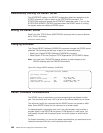Permanent
A BOOTP or DHCP client leases an IP address for an infinite period of time. No
process of lease renewal is required.
Planning for DHCP
Before you put DHCP into effect in your network, you need to make the following
decisions:
v How many DHCP servers do you need?
v Do you already have BOOTP servers in your network?
v Do you have hosts with special requirements?
v What is a reasonable lease time?
How Many DHCP Servers do you Need?
The number of servers that you need depends largely on the number of subnets
you have and the number of DHCP clients that you plan to support. It also depends
on the lease time that you choose and whether your routers (or individual
computers on the subnets) are enabled with BOOTP Relay. Keep in mind that the
DHCP protocols do not currently define server-to-server communication. Therefore,
they cannot share information, and one DHCP server cannot perform as a
hot
backup
if the other one fails.
DHCP clients send broadcast messages. By design, broadcast messages do not
cross subnets. To allow the client’s messages to be forwarded outside its subnet,
you must configure a BOOTP/DHCP Relay Agent. Otherwise, you must configure a
DHCP server on each subnet.
Note: Many routers available today can act as a BOOTP/DHCP Relay Agent.
Software is also available for some operating system platforms that enable a
regular computer on the network to act as a BOOTP/DHCP Relay Agent. On
the AS/400 system, BOOTP/DHCP Relay capability comes standard as part
of the DHCP server.
Using a Single DHCP Server:
If you choose to use a single DHCP server to
serve hosts on a subnet, you must consider the effects if the single server fails.
Generally, the failure of a server affects only those DHCP clients that attempt to join
the network. DHCP clients already on the network typically continue operating
unaffected until their lease expires. However, clients with a short lease time might
lose their network access before you can restart the server.
Using Multiple DHCP Servers:
To avoid a single point of failure, you can
configure two or more DHCP servers to serve the same subnet. If one server fails,
the other continues to serve the subnet. Each of the DHCP servers must be
accessible either by direct attachment to the subnet or by using a BOOTP/DHCP
Relay Agent. Remember that you cannot run more than one DHCP server on any
individual system. Multiple DHCP servers require multiple systems.
Because two DHCP servers cannot serve the same addresses, address pools that
you define for a subnet must be unique across DHCP servers. Therefore, when
using two or more DHCP servers to serve a particular subnet, you must divide the
complete list of addresses for that subnet among the servers. Configure one server
with an address pool that consists of 70% of the available addresses for the subnet.
Configure the other server with an address pool that consists of the remaining 30%
of the available addresses.
406 OS/400 TCP/IP Configuration and Reference V4R4


















